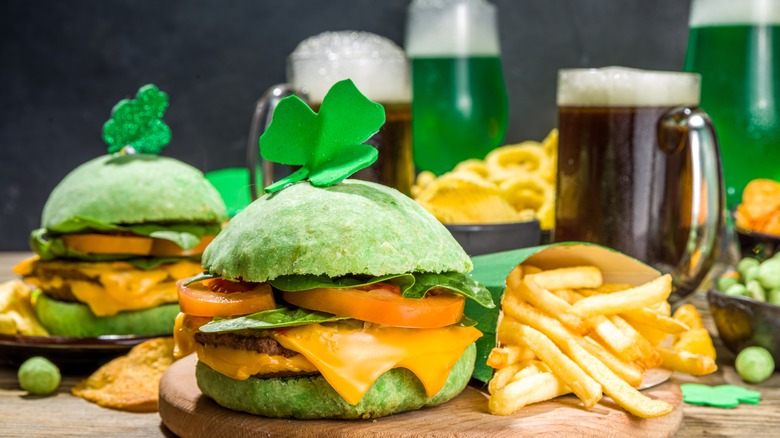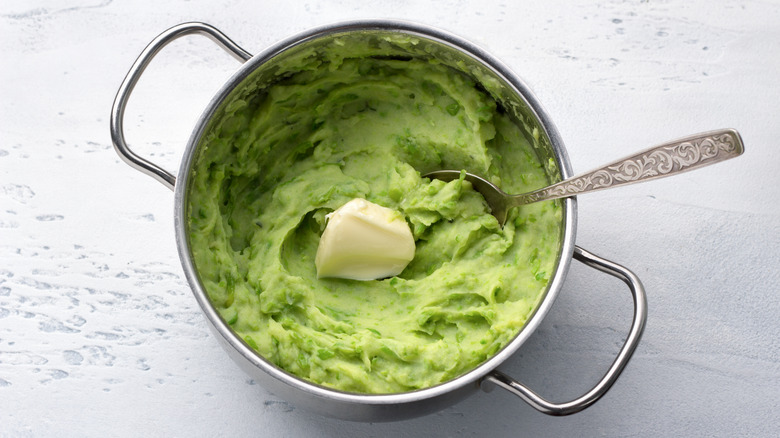Naturally Dye Your St. Patrick's Day Food With Spinach
St. Patrick's Day is an Irish cultural and religious holiday, but many traditions associated with the occasion actually began in the United States. Since 1601, when modern St. Augustine, Florida held its first St. Patrick's Day parade, Americans have commemorated the day with plenty of corned beef, cabbage, and lots of green dye. If you want to celebrate St. Paddy's Day with a green-tinged feast, but you hesitate to reach for artificial food dyes, turn to a more nutritious option: spinach.
Spinach can be the source of a powerful natural dye that's inexpensive, easy to make, and doesn't impart a strong taste to your food. Several other vegetables and plants can also color foods in varying shades of green; however, spinach is the way to go if you want a rich, deep hue. The greens are widely available year-round and can color everything from baked goods to mashed potatoes and even St. Patrick's day desserts.
To make this easy green dye, purèe one cup of chopped spinach with two cups of hot water. If you don't have a blender, just boil and then simmer the mixture for an hour. Avoid using baby spinach, as older, mature leaves give better results. Strain the pulpy mixture through cheesecloth to create a vivid yet neutral-tasting liquid. From there, it's effortless to mix the dye into your favorite recipes.
Spinach can dye a variety of St. Paddy's day treats
Lightly-colored foods and clear beverages are the best candidates for dyeing green. Start your day off in a festive way by adding your spinach dye to waffle or pancake mix. If you prefer a savory breakfast, take inspiration from Dr. Seuss and prepare green eggs and ham by scrambling eggs with the dye. This will surely amuse any kids in your family.
If you're preparing the traditional "New England" boiled dinner served on St. Patrick's Day, i.e. corned beef and vegetables, use the dye to make your potatoes a fun green shade. Boil halved new potatoes in several cups of spinach dye, and garnish the side dish with fresh green herbs for a special touch. Or, combine a few tablespoons of the dye with warm milk and melted butter and add it to mashed potatoes. Serve them on their own, on top of a shepherd's pie, or use them to make colcannon, the Irish side dish of mashed potatoes with bacon and cabbage.
Spinach dye works also well on baked goods, turning doughs and icings into the perfect shade of green. Beyond frosting cupcakes and such, try using the colorant in any recipe made with white flour, like chewy bagels, basic scones, or even homemade burger buns. You can also use the natural dye to prepare fresh green pasta dough, or make emerald-colored pizza dough loaded with green toppings like pesto, bell peppers, olives, or broccoli.
Other methods to naturally dye food green
Other veggies and herbs can also dye your food in place of or in addition to spinach. Just add them to the blender and prepare the dye in the same way as a spinach version. Depending on the ingredients and how much dye you use, the colorant may slightly alter the flavor of your dishes, so pair up your veggies and plants with recipes that won't clash with their taste.
For a softer shade of green, boil roughly-chopped artichokes in water to release their color. Fresh herbs such as mint, sorrel, tarragon, chamomile, parsley, and cilantro can create herbaceous green pigments suited for both sweet and savory dishes. Consider using them in vanilla ice cream or sugar cookies to add a vivid hue and balance their sweetness.
Surprisingly, the red onion skins that we commonly toss in the trash can make for a vibrant chartreuse dye when boiled in plenty of water. The peels' color will change from red to green in a truly impressive manner. However, you'd best reserve this dye for savory recipes. Green peas can also make for a decent dye, or you can smoothly purèe them and mix into mashed potatoes and other ingredients. Create a fun St. Patrick's Day appetizer by combining green pea dye or purèe with a soft cheese like ricotta, creating a delicious chip dip or crostini spread.



